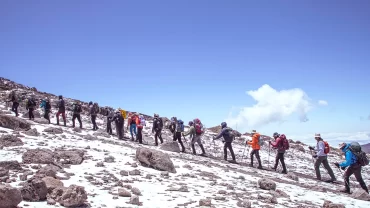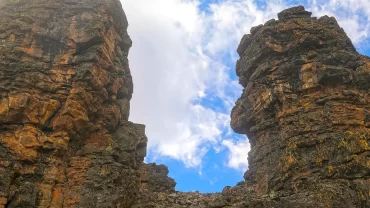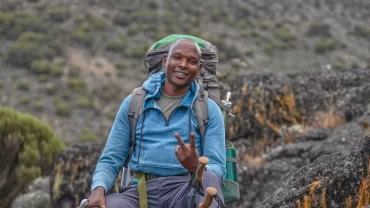Machame Route Kilimanjaro
1. Introduction to the Machame Route
The Machame Route, famously known as the Whiskey Route, is one of the most popular and breathtaking trails on Mount Kilimanjaro (5,895m / 19,341 ft). It offers an adventurous ascent with stunning landscapes, diverse ecological zones, and excellent acclimatization opportunities.
Unlike the Marangu Route (Coca-Cola Route), which is considered the easiest, the Machame Route is more physically demanding but provides better acclimatization, increasing summit success rates. Its popularity means a more social trekking experience, perfect for those who enjoy camaraderie on the trail.
2. Key Facts About the Machame Route
- Distance: ~62 km (37 miles)
- Duration: 6-7 days
- Difficulty Level: Moderate to Challenging
- Scenery: Rainforest, moorlands, alpine desert, and glaciers
- Acclimatization Profile: Good (climb high, sleep low strategy)
- Success Rate: ~85% for 7-day trek, ~75% for 6-day trek
- Accommodation: Tents only (no huts)
- Best Time to Climb: January-March & June-October
3. Route Overview & Highlights
The Machame Route approaches Kilimanjaro from the southwest and gradually circles eastward, passing beneath the spectacular Southern Icefields before reaching the summit at Uhuru Peak. The trail passes through five distinct ecological zones, including lush rainforests, expansive moorlands, high-altitude deserts, and glacial landscapes.
What Makes the Machame Route Unique?
✅ One of the most scenic routes on Kilimanjaro
✅ Great acclimatization profile due to “climb high, sleep low” technique
✅ Higher summit success rate than Marangu and Rongai Routes
✅ Varied landscapes and wildlife spotting opportunities
✅ A more adventurous trekking experience with steeper sections
4. Who Should Choose This Route?
✅ Best for:
- Trekkers with good fitness levels who enjoy a moderate challenge.
- Those looking for a scenic and rewarding trek with diverse terrain.
- Hikers who prefer tent camping over huts.
- Those wanting a social trekking experience (popular route).
❌ Avoid if:
- You prefer shorter, easier routes (consider Marangu Route instead).
- You have limited time (Lemosho or Rongai may be better alternatives).
- You prefer quieter, less crowded trails (opt for Northern Circuit or Rongai).
5. Pros & Cons of the Machame Route
✅ Pros:
- Incredible scenery throughout the trek.
- Better acclimatization profile, increasing success rates.
- A more challenging and adventurous climb.
- Social atmosphere due to its popularity.
❌ Cons:
- Can be crowded during peak seasons.
- No hut accommodations (camping only).
- Steep and strenuous sections, especially the Barranco Wall.
6. Acclimatization & Success Rate
One of the biggest advantages of the Machame Route is its excellent acclimatization profile. The route follows the “climb high, sleep low” strategy, which is key to reducing the risk of Acute Mountain Sickness (AMS).
- 7-day itinerary: ~85% summit success rate (recommended).
- 6-day itinerary: ~75% summit success rate (more challenging).
This makes the Machame Route one of the best options for acclimatization among all Kilimanjaro routes.
For more insights on altitude adaptation, check out Acclimatization on Kilimanjaro.
7. Challenges & Difficulty Level
The Machame Route is categorized as moderate to challenging, with some steep ascents and descents. Key challenges include:
- Long daily trekking distances, especially on summit night.
- Steep terrain, particularly at the Barranco Wall and the final push to Uhuru Peak.
- Cold and high-altitude conditions, requiring proper acclimatization.
Recommended Training:
- Cardio workouts (hiking, jogging, cycling) to improve endurance.
- Strength training (leg muscles, core strength for balance).
- Altitude training if possible (hiking at high elevations before the trek).
For a full training guide, check out Getting Ready to Conquer the Climb.
8. Best Time to Hike the Machame Route
The best times to climb Mount Kilimanjaro via the Machame Route are:
✅ January – March: Less crowded, cooler temperatures, clear skies.
✅ June – October: Peak season, drier weather, but busier trails.
❌ April – May & November: Rainy season, trails can be slippery and more challenging.
For a month-by-month breakdown, read The Best Time to Climb Kilimanjaro.
9. Packing & Preparation Tips
Since the Machame Route involves camping in high-altitude environments, packing the right gear is essential.
Key Packing Items:
- Layered clothing (base layers, insulated layers, waterproof shell).
- Warm sleeping bag (rated for -10°C to -20°C).
- Trekking poles for steep ascents and descents.
- Hydration system (CamelBak or water bottles).
- Headlamp for summit night.
- Sunscreen, sunglasses, and lip balm (high UV exposure).
For a complete list, check out The Ultimate Tanzania Adventure Packing List.
10. Comparing the Machame Route with Other Kilimanjaro Routes
| Route | Difficulty | Scenery | Acclimatization | Success Rate |
| Machame | Moderate-Challenging | Excellent | Good | ~85% (7-day trek) |
| Marangu | Easiest | Moderate | Poor | ~50-60% |
| Lemosho | Challenging | Best | Excellent | ~90% (8-day trek) |
| Rongai | Moderate | Good | Average | ~75-80% |
| Northern Circuit | Longest & Easiest | Excellent | Best | ~95% (9-day trek) |
For an in-depth comparison, check out How to Choose the Best Kilimanjaro Route.
11. Final Thoughts: Is Machame the Right Route for You?
The Machame Route is an excellent choice for climbers looking for a scenic, adventurous, and rewarding Kilimanjaro experience. With high success rates, stunning landscapes, and good acclimatization, it remains one of the top choices for trekkers worldwide.
Are you ready to take on Kilimanjaro via the Machame Route? Start your adventure today!





Comment (0)